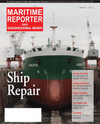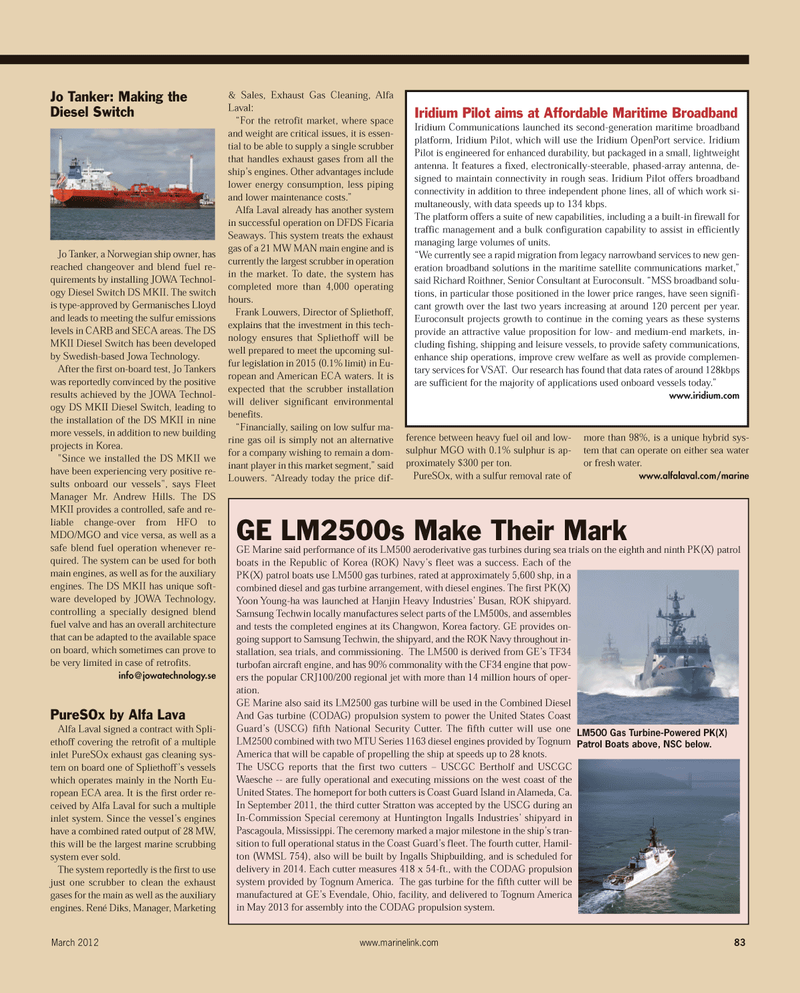
Page 83: of Maritime Reporter Magazine (March 2012)
The Ship Repair Edition
Read this page in Pdf, Flash or Html5 edition of March 2012 Maritime Reporter Magazine
Jo Tanker: Making the Diesel SwitchJo Tanker, a Norwegian ship owner, has reached changeover and blend fuel re- quirements by installing JOWA Technol- ogy Diesel Switch DS MKII. The switch is type-approved by Germanisches Lloyd and leads to meeting the sulfur emissionslevels in CARB and SECA areas. The DS MKII Diesel Switch has been developed by Swedish-based Jowa Technology. After the first on-board test, Jo Tankers was reportedly convinced by the positive results achieved by the JOWA Technol- ogy DS MKII Diesel Switch, leading tothe installation of the DS MKII in ninemore vessels, in addition to new building projects in Korea. "Since we installed the DS MKII wehave been experiencing very positive re- sults onboard our vessels", says Fleet Manager Mr. Andrew Hills. The DS MKII provides a controlled, safe and re- liable change-over from HFO to MDO/MGO and vice versa, as well as a safe blend fuel operation whenever re- quired. The system can be used for both main engines, as well as for the auxiliaryengines. The DS MKII has unique soft- ware developed by JOWA Technology, controlling a specially designed blendfuel valve and has an overall architecture that can be adapted to the available space on board, which sometimes can prove to be very limited in case of retrofits. [email protected] PureSOx by Alfa Lava Alfa Laval signed a contract with Spli- ethoff covering the retrofit of a multiple inlet PureSOx exhaust gas cleaning sys- tem on board one of Spliethoff?s vessels which operates mainly in the North Eu-ropean ECA area. It is the first order re- ceived by Alfa Laval for such a multiple inlet system. Since the vessel?s engines have a combined rated output of 28 MW, this will be the largest marine scrubbing system ever sold. The system reportedly is the first to use just one scrubber to clean the exhaust gases for the main as well as the auxiliary engines. René Diks, Manager, Marketing & Sales, Exhaust Gas Cleaning, Alfa Laval: ?For the retrofit market, where space and weight are critical issues, it is essen-tial to be able to supply a single scrubberthat handles exhaust gases from all the ship?s engines. Other advantages include lower energy consumption, less piping and lower maintenance costs.? Alfa Laval already has another system in successful operation on DFDS FicariaSeaways. This system treats the exhaust gas of a 21 MW MAN main engine and is currently the largest scrubber in operation in the market. To date, the system has completed more than 4,000 operatinghours.Frank Louwers, Director of Spliethoff, explains that the investment in this tech- nology ensures that Spliethoff will be well prepared to meet the upcoming sul-fur legislation in 2015 (0.1% limit) in Eu- ropean and American ECA waters. It is expected that the scrubber installation will deliver significant environmental benefits. ?Financially, sailing on low sulfur ma- rine gas oil is simply not an alternative for a company wishing to remain a dom- inant player in this market segment,? said Louwers. ?Already today the price dif- ference between heavy fuel oil and low- sulphur MGO with 0.1% sulphur is ap-proximately $300 per ton. PureSOx, with a sulfur removal rate of more than 98%, is a unique hybrid sys- tem that can operate on either sea water or fresh water. www.alfalaval.com/marine March 2012www.marinelink.com 83Iridium Pilot aims at Affordable Maritime Broadband Iridium Communications launched its second-generation maritime broadbandplatform, Iridium Pilot, which will use the Iridium OpenPort service. IridiumPilot is engineered for enhanced durability, but packaged in a small, lightweight antenna. It features a fixed, electronically-steerable, phased-array antenna, de- signed to maintain connectivity in rough seas. Iridium Pilot offers broadband connectivity in addition to three independent phone lines, all of which work si- multaneously, with data speeds up to 134 kbps. The platform offers a suite of new capabilities, including a a built-in firewall for traffic management and a bulk configuration capability to assist in efficiently managing large volumes of units. ?We currently see a rapid migration from legacy narrowband services to new gen- eration broadband solutions in the maritime satellite communications market,? said Richard Roithner, Senior Consultant at Euroconsult. ?MSS broadband solu- tions, in particular those positioned in the lower price ranges, have seen signifi- cant growth over the last two years increasing at around 120 percent per year. Euroconsult projects growth to continue in the coming years as these systems provide an attractive value proposition for low- and medium-end markets, in- cluding fishing, shipping and leisure vessels, to provide safety communications, enhance ship operations, improve crew welfare as well as provide complemen- tary services for VSAT. Our research has found that data rates of around 128kbps are sufficient for the majority of applications used onboard vessels today.? www.iridium.com GE LM2500s Make Their MarkGE Marine said performance of its LM500 aeroderivative gas turbines during sea trials on the eighth and ninth PK(X) patrol boats in the Republic of Korea (ROK) Navy?s fleet was a success. Each of the PK(X) patrol boats use LM500 gas turbines, rated at approximately 5,600 shp, in a combined diesel and gas turbine arrangement, with diesel engines. The first PK(X) Yoon Young-ha was launched at Hanjin Heavy Industries? Busan, ROK shipyard. Samsung Techwin locally manufactures select parts of the LM500s, and assembles and tests the completed engines at its Changwon, Korea factory. GE provides on- going support to Samsung Techwin, the shipyard, and the ROK Navy throughout in- stallation, sea trials, and commissioning. The LM500 is derived from GE?s TF34 turbofan aircraft engine, and has 90% commonality with the CF34 engine that pow- ers the popular CRJ100/200 regional jet with more than 14 million hours of oper- ation. GE Marine also said its LM2500 gas turbine will be used in the Combined Diesel And Gas turbine (CODAG) propulsion system to power the United States Coast Guard?s (USCG) fifth National Security Cutter. The fifth cutter will use one LM2500 combined with two MTU Series 1163 diesel engines provided by Tognum America that will be capable of propelling the ship at speeds up to 28 knots.The USCG reports that the first two cutters ? USCGC Bertholf and USCGC Waesche -- are fully operational and executing missions on the west coast of the United States. The homeport for both cutters is Coast Guard Island in Alameda, Ca. In September 2011, the third cutter Stratton was accepted by the USCG during an In-Commission Special ceremony at Huntington Ingalls Industries? shipyard in Pascagoula, Mississippi. The ceremony marked a major milestone in the ship?s tran- sition to full operational status in the Coast Guard?s fleet. The fourth cutter, Hamil- ton (WMSL 754), also will be built by Ingalls Shipbuilding, and is scheduled for delivery in 2014. Each cutter measures 418 x 54-ft., with the CODAG propulsion system provided by Tognum America. The gas turbine for the fifth cutter will be manufactured at GE?s Evendale, Ohio, facility, and delivered to Tognum America in May 2013 for assembly into the CODAG propulsion system. LM500 Gas Turbine-Powered PK(X) Patrol Boats above, NSC below. MR March 12 # 11 (81-88):MR Template 3/6/2012 1:24 PM Page 83

 82
82

 84
84
